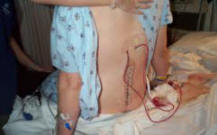Posts
- Small Fiber neuropathy
- neurological effects of CIDP
- Colostruma
- Lupus page
- SLE Home page
- Caveman Diet
- Homocysteine Lowering diet
- Iodine deficient diet
- Epilepsy diet
- Food additives
- No artificial sweetener in diet
- Vinegar Benefits'
- Loss of apetitite
- Breast cancer herbs
- The best lifestyle
- DeTox diet
- Avoid Gum
- Right Fat Diet
- chemicals in French fries
- Electrical Stimulation Therapy
- Magnets and ageing
- Cupping
- Schizophrenia research here to stay
- autoimmune dementia
- End To Parkinson
- Kamut Grain
- LazyEye
- What is Chronic Fatigue
- irregular periods
- Myasthenia diet
- cancer survivor
- Tomato as a medicine
- Prevent Osteoporosis
- Some rheumatic disorders
- Polymyositis
 Just a month after back surgery, Nancy Scatena was once again in excruciating pain. The medications her doctor prescribed barely took the
edge off the unrelenting back aches and searing jolts down her left leg. The pain just kept intensifying, says the 52-year-old Scottsdale,
Ariz., woman who suffers from spinal stenosis, a narrowing of the chanel through which spinal nerves pass.
I was suicidal.
Just a month after back surgery, Nancy Scatena was once again in excruciating pain. The medications her doctor prescribed barely took the
edge off the unrelenting back aches and searing jolts down her left leg. The pain just kept intensifying, says the 52-year-old Scottsdale,
Ariz., woman who suffers from spinal stenosis, a narrowing of the chanel through which spinal nerves pass.
I was suicidal.
